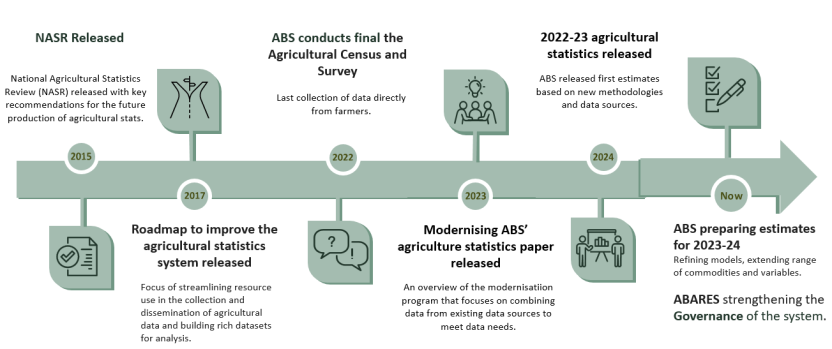The challenge
The ABS traditionally produced agricultural statistics through an annual agricultural survey or the five yearly Agricultural Census which collected information directly from farm businesses.
This meant detailed regional data was only captured every 5 years, which was not regular enough for the government and the agriculture industry to understand change at regional levels. It was time consuming for farmers and businesses to report this data, which meant response rates and resulting data quality were declining.
The increasing availability of other quality data being produced through existing business processes created an opportunity for the ABS to modernise the way we produce agricultural statistics and save farmers from filling out surveys.
The solution
A key part of modernisation has been to create partnerships to access, understand and integrate high quality existing data sources into official ABS statistics. Partnering with DAS (Digital Agriculture Services), a technology company that delivers rural-specific location intelligence, has enabled the ABS to produce agriculture statistics at a faster pace and with greater regional detail.
DAS provides the ABS with detailed crop area data for Australia’s 14 most significant winter and summer broadacre crops including canola, wheat and barley. The data provided by DAS is produced by applying machine learning to satellite data to classify the crop type growing in every paddock on mainland Australia. This level of detail and frequency of data collection on Australian crops has not previously been possible and enables new understanding of Australian agricultural production. DAS’ data is combined with existing administrative data to produce yearly regional production, value, area and business statistics about Australia’s biggest crops.
Combining existing data sources in partnership with industry experts results in more accurate official statistics that are consistent with other data sources. This consistency means the statistics are trusted to inform important decisions about Australian agriculture by the industry and government.
The results
There are many benefits for the agricultural industry and farmers when statistics are produced more regularly and accurately. These statistics help to better inform policy-making decisions that directly impact growers and
producers. This includes improving biosecurity responses, helping farmers financially in the event of a natural disaster or upgrading road infrastructure for better supply chains.
Producing agricultural data at a regional level yearly, instead of every five years, ensures statistics provide timely insights into how changes in climate and trade are impacting what is being grown and where. Regional data
enables researchers to understand how these changes might impact regional communities and economies.
For farmers, the move from surveys to satellites and other existing data has resulted in a 97% decrease in the time they spend completing ABS agriculture surveys.
The ABS are continuing to grow our partnerships with other parts of government, agricultural industry groups and businesses to improve agriculture statistics and minimise the time farmers spend reporting information.

